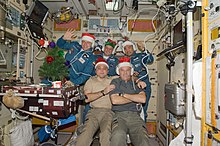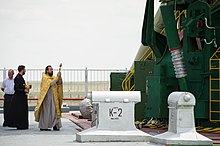Religion in space
Astronauts and other spaceflight participants have observed their religions while in space; sometimes publicly, sometimes privately. Religious adherence in outer space poses unique challenges and opportunities for practitioners. Space travelers have reported profound changes in the way they view their faith related to the overview effect,[1] while some secular groups have criticized the use of government spacecraft for religious activities by astronauts.[2]
Christianity
[edit]Apollo 8 Genesis Reading
[edit]On Christmas Eve, 1968 astronauts Bill Anders, Jim Lovell, and Frank Borman read from the Book of Genesis as Apollo 8 orbited the Moon.[3] A lawsuit by American Atheists founder Madalyn Murray O'Hair alleged that the observance amounted to a government endorsement of religion in violation of the First Amendment,[4] but the case was dismissed.


Protestantism
[edit]Apollo 11 astronaut Buzz Aldrin, a Presbyterian, performed a communion service for himself using a kit provided by his church. Aldrin had told flight director Chris Kraft of his plans and intended to broadcast the service back to Earth but opted not to at the request of Deke Slayton, due to the continuing controversy over Apollo 8's reading.[5]
A microfilm Bible brought to the surface of the Moon by Apollo 14 astronaut Ed Mitchell was auctioned off in 2011.[6] It was a King James Version created after three astronauts lost their lives in the Apollo 1 fire.[6] Ed White, one of the astronauts who perished, had wanted to take a Bible to the Moon.[6]
On the 2009 STS-128 flight to the International Space Station, astronaut Patrick Forrester brought a fragment of a Missionary Aviation Fellowship aircraft which had been used by the Operation Auca martyrs in Ecuador in 1956.[7]
Several members of the crew of the Space Shuttle Challenger tragedy mission STS-51-L were people of faith. Among them were Commander Dick Scobee and Pilot Michael J. Smith. Scobee was a Baptist who met his wife June at a church social event. After the tragedy, she would go on to write an article in Guidepost Magazine about how their faith helped her through the tragic time. Smith and his family attended a non-denominational Christian church in a community close to their home near Houston's NASA JSC Space Center.
Rick Husband, the Commander of the ill-fated STS-107 Columbia tragedy mission, was also a devout Christian. On the last-request forms that astronauts fill out before every flight, he left his pastor a personal note: "Tell them about Jesus; he's real to me." Later his wife Evelyn wrote a book about their life with him as an astronaut and the importance of their Christian faith entitled High Calling: The Courageous Life and Faith of Space Shuttle Columbia Commander Rick Husband. Likewise, his STS-107 crewmate Michael P. Anderson was also a devout Christian and when not on a mission for NASA, was an active member of the Grace Community Church choir.
Catholicism
[edit]A signed message from Pope Paul VI was included among statements from dozens of other world leaders left on the Moon on a silicon disk during the Apollo 11 mission.[8] Following the mission, William Donald Borders, Bishop of the Roman Catholic Diocese of Orlando, told the Pope that the 1917 Code of Canon Law placed the Moon within his diocese, as the first explorers had departed from Cape Kennedy which was under his jurisdiction. The claim was neither confirmed nor denied by the Pope, and the Moon is not recognized as part of the diocese in any official capacity.[9][10][11]
Following Buzz Aldrin's communion on the Moon, other astronauts have done the same in Earth orbit. Three Catholic astronauts on Space Shuttle mission STS-59 received Holy Communion on 17 April 1994.[12] NASA astronaut Michael S. Hopkins took a supply of six consecrated hosts to the International Space Station in September 2013, allowing him to receive the Eucharist weekly during his 24-week mission.[13]
In May 2011, Pope Benedict XVI of the Catholic Church talked to the crew of the Space Shuttle Endeavour while it was in Earth orbit.[14]
Russian Orthodox
[edit]In Russia, spaceflight crews are blessed by Russian Orthodox priests before launch, and their Soyuz rockets are also blessed on the launch pad. Cosmonaut Aleksandr Viktorenko initiated the crew blessing tradition when he requested one for the launch of Soyuz TM-20 in 1994.[15][16]

Russian Orthodox Christmas was celebrated on the International Space Station, on January 7, 2011.[17] Cosmonauts had the day off, but one of the other crew posted on Twitter, "Merry Christmas to all Russia."[17] The whole crew also celebrated on December 25, two weeks prior.[17]
Cosmonauts sometimes at the request of Russian Orthodox church carry religious icons to space, which upon return to Earth are distributed to churches.[18]
Islam
[edit]Muslims in space struggle with fulfilling their religious obligations including kneeling and facing Mecca to pray in microgravity traveling at several kilometres per second. The issue first came up when Sultan bin Salman bin Abdulaziz Al Saud, a Saudi prince, flew aboard STS-51-G and again when Anousheh Ansari flew as a tourist to the International Space Station.[19] In preparation for Malaysian Sheikh Muszaphar Shukor's trip to the ISS in 2007, the National Fatwa Council created "Muslim Obligations in the International Space Station" outlining permissible modifications to rituals such as kneeling when praying (not required in space), facing Mecca (or just Earth)[20] when praying (left to the astronaut's best abilities at the start of prayer), and washing (a wet towel will suffice).[21]
In February 2014, the General Authority of Islamic Affairs and Endowment (GAIAE) from Saudi Arabia issued a fatwa forbidding devout Muslims from participating as crew members in Mars One's proposed one-way mission to Mars.[22] Speaking for the clerical group, Farooq Hamada explained that, "Protecting life against all possible dangers and keeping it safe is an issue agreed upon by all religions and is clearly stipulated in verse 4/29 of the Holy Quran: Do not kill yourselves or one another. Indeed, Allah is to you ever Merciful."[23]
Judaism
[edit]Time and date-related observances are important in Judaism, and there have been considerations on the observance of time by Jewish astronauts.[24]
American astronaut Jeffrey Hoffman took multiple Jewish objects to space on his space flights from 1985 to 1996: a miniature Torah scroll, a yad, a Torah breastplate, mezuzot, menorahs, a dreidel, hand-woven tallit, and kiddush cups.[25][26]
In January 2003, a microfilm Torah, a handwritten copy of the Shabbat kiddush, and a miniature Torah scroll rescued from the Bergen-Belsen concentration camp were taken to space by Israeli astronaut Ilan Ramon aboard the Space Shuttle Columbia.[14] Ramon and the rest of the crew died when the shuttle disintegrated during reentry. In September 2006, Canadian astronaut Steve MacLean took another Torah from Bergen-Belsen aboard the Space Shuttle Atlantis to the International Space Station as a tribute to Ramon.[27]
Hinduism
[edit]In December 2006, American astronaut Sunita Williams took a copy of the Bhagavad Gita to the International Space Station. In July 2012, she took there an Om symbol and a copy of the Upanishads.[28] On 27 February 2021, PSLV-C51 carried a digital copy of the Bhagavad Gita into space on an SD card.[29]
See also
[edit]References
[edit]- ^ "Astronauts report an "overview effect" from the awe of space travel—and you can replicate it here on Earth". 6 September 2015. Archived from the original on 2020-04-22. Retrieved 2020-05-07.
- ^ "O'Hair v. Paine, 397 U.S. 531". Findlaw. 1970. Archived from the original on 2012-10-21. Retrieved 2008-02-13.
- ^ Haney, Paul (August 10, 2009). "Further reflections on a golden space era". Archived from the original on February 2, 2018. Retrieved 2009-09-03.
- ^ Chaikin, Andrew (1994). A Man On The Moon: The Voyages of the Apollo Astronauts. Viking. pp. 204, 623. ISBN 0-670-81446-6.
- ^ "Communion in Space". Guideposts. October 1970.
- ^ a b c Menzie, Nicola (2011). "NASA's First Bible on the Moon to Be Auctioned Off". The Christian Post. Archived from the original on 2019-05-24. Retrieved 2011-12-26.
- ^ Wood, Janice (October 5, 2009). "Astronaut returns to Earth with piece of missionary history". IGeneral Aviation News. Archived from the original on April 29, 2023. Retrieved April 29, 2023.
- ^ "Apollo 11 Goodwill Messages" (PDF). Archived (PDF) from the original on 2019-09-03. Retrieved 2020-05-07.
- ^ "Remembering the Bishop of the Moon". Archived from the original on 2016-06-21. Retrieved 2016-06-28.
- ^ "Did Apollo 11 mission make Orlando's founding bishop the bishop of moon?". Crux. 2019-07-20. Archived from the original on 2023-09-03. Retrieved 2023-09-09.
- ^ "Yes, the moon has its own Catholic Bishop". Aleteia.org. 2018-08-03. Archived from the original on 2023-02-11. Retrieved 2023-09-09.
- ^ "When Astronauts Received Holy Communion in Space". National Catholic Register. February 21, 2017. Archived from the original on September 11, 2019. Retrieved 2019-08-12.
- ^ Dennis Sadowski (April 7, 2016). "For Catholic astronauts, flying to space doesn't mean giving up the faith". Catholic News Service. Archived from the original on May 25, 2019. Retrieved 2019-08-12.
- ^ a b Patterson, Thom (7 July 2011). "The surprising history of prayer in space". CNN. Archived from the original on 24 May 2019.
- ^ Azriel, Merryl (2012-05-28). "A Tradition Continues: Blessing the Soyuz". Space Safety Magazine.
- ^ Corvaja, S. (2020-07-19). "Soyuz MS-13 crew receive the traditional blessing from a Russian Orthodox priest". European Space Agency.
- ^ a b c January 2011, Tariq Malik 07 (7 January 2011). "Christmas Comes Twice for Russians in Space". Space.com. Archived from the original on 2020-11-24. Retrieved 2021-03-19.
{{cite web}}: CS1 maint: numeric names: authors list (link) - ^ "The artworks flown to outer space". Apollo Magazine. 2021-10-21. Archived from the original on 2021-12-21. Retrieved 2021-12-21.
The cosmonaut tradition, meanwhile, is to take religious icons depicting saints or the holy family on to space stations. As recent research which we conducted in collaboration with the icon scholar Wendy Salmond shows, this is sometimes at the request of the Patriarch of the Russian Orthodox church. The returned icons are not sold but distributed to churches.
- ^ Gartner, Bettina (October 10, 2007). "How does an Islamic astronaut face Mecca in orbit?". Christian Science Monitor. Archived from the original on September 6, 2009. Retrieved 2009-09-03.
- ^ "Muslims in Outer Space". Religion and Public Life at Harvard Divinity School. 2007-10-10. Retrieved 2024-09-12.
- ^ "Astronaut to grapple with daily prayer ritual". NBC News. September 20, 2007. Archived from the original on February 10, 2015. Retrieved 2009-09-03.
- ^ "Ulama Arab Saudi Mengeluarkan Fatwa Melarang Muslim ke Mars". Satu Harapan (in Indonesian). 2013-11-03. Archived from the original on 2019-06-18. Retrieved 2019-06-18.
- ^ "Muslim clerics issue fatwa banning the devout from Mars One 'suicide' mission". The A Register. February 22, 2014. Archived from the original on February 22, 2014. Retrieved 2014-02-22.
- ^ Wattles, Jackie (December 7, 2021). "How to practice religion could be a big question for some space tourists". CNN. Archived from the original on February 8, 2022. Retrieved April 29, 2023.
- ^ Keva, Bette (26 June 2019). "Document in works about astronaut who brought Torah deep into space". Jewish Journal. Archived from the original on 9 April 2021.
- ^ Fein, Judie. "The Ultimate Jewish Traveler". Chabad.org. Archived from the original on 9 April 2021. Retrieved 9 April 2021.
- ^ Weiman, Racelle R. (29 December 2006). "Sacred flight". Jewish News of Greater Phoenix. Archived from the original on 9 April 2021.
- ^ "Sunita Williams sends out Diwali greetings from space". TimeS NOW. 14 November 2012. Archived from the original on 31 March 2021.
- ^ "Brazil's Amazonia-1 on board with Bhagavad Gita". 28 February 2021. Archived from the original on 28 February 2021. Retrieved 28 February 2021.

